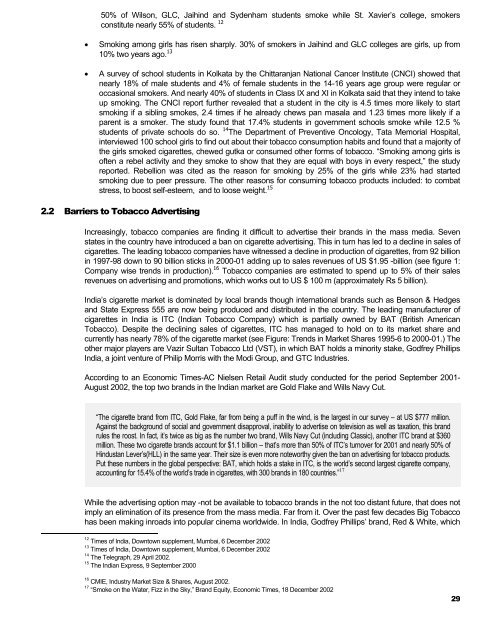Professional Report - Smoke Free Movies
Professional Report - Smoke Free Movies
Professional Report - Smoke Free Movies
Create successful ePaper yourself
Turn your PDF publications into a flip-book with our unique Google optimized e-Paper software.
50% of Wilson, GLC, Jaihind and Sydenham students smoke while St. Xavier’s college, smokers<br />
constitute nearly 55% of students. 12<br />
• Smoking among girls has risen sharply. 30% of smokers in Jaihind and GLC colleges are girls, up from<br />
10% two years ago. 13<br />
• A survey of school students in Kolkata by the Chittaranjan National Cancer Institute (CNCI) showed that<br />
nearly 18% of male students and 4% of female students in the 14-16 years age group were regular or<br />
occasional smokers. And nearly 40% of students in Class IX and XI in Kolkata said that they intend to take<br />
up smoking. The CNCI report further revealed that a student in the city is 4.5 times more likely to start<br />
smoking if a sibling smokes, 2.4 times if he already chews pan masala and 1.23 times more likely if a<br />
parent is a smoker. The study found that 17.4% students in government schools smoke while 12.5 %<br />
students of private schools do so. 14 The Department of Preventive Oncology, Tata Memorial Hospital,<br />
interviewed 100 school girls to find out about their tobacco consumption habits and found that a majority of<br />
the girls smoked cigarettes, chewed gutka or consumed other forms of tobacco. “Smoking among girls is<br />
often a rebel activity and they smoke to show that they are equal with boys in every respect,” the study<br />
reported. Rebellion was cited as the reason for smoking by 25% of the girls while 23% had started<br />
smoking due to peer pressure. The other reasons for consuming tobacco products included: to combat<br />
stress, to boost self-esteem, and to loose weight. 15<br />
2.2 Barriers to Tobacco Advertising<br />
Increasingly, tobacco companies are finding it difficult to advertise their brands in the mass media. Seven<br />
states in the country have introduced a ban on cigarette advertising. This in turn has led to a decline in sales of<br />
cigarettes. The leading tobacco companies have witnessed a decline in production of cigarettes, from 92 billion<br />
in 1997-98 down to 90 billion sticks in 2000-01 adding up to sales revenues of US $1.95 -billion (see figure 1:<br />
Company wise trends in production). 16 Tobacco companies are estimated to spend up to 5% of their sales<br />
revenues on advertising and promotions, which works out to US $ 100 m (approximately Rs 5 billion).<br />
India’s cigarette market is dominated by local brands though international brands such as Benson & Hedges<br />
and State Express 555 are now being produced and distributed in the country. The leading manufacturer of<br />
cigarettes in India is ITC (Indian Tobacco Company) which is partially owned by BAT (British American<br />
Tobacco). Despite the declining sales of cigarettes, ITC has managed to hold on to its market share and<br />
currently has nearly 78% of the cigarette market (see Figure: Trends in Market Shares 1995-6 to 2000-01.) The<br />
other major players are Vazir Sultan Tobacco Ltd (VST), in which BAT holds a minority stake, Godfrey Phillips<br />
India, a joint venture of Philip Morris with the Modi Group, and GTC Industries.<br />
According to an Economic Times-AC Nielsen Retail Audit study conducted for the period September 2001-<br />
August 2002, the top two brands in the Indian market are Gold Flake and Wills Navy Cut.<br />
“The cigarette brand from ITC, Gold Flake, far from being a puff in the wind, is the largest in our survey – at US $777 million.<br />
Against the background of social and government disapproval, inability to advertise on television as well as taxation, this brand<br />
rules the roost. In fact, it’s twice as big as the number two brand, Wills Navy Cut (including Classic), another ITC brand at $360<br />
million. These two cigarette brands account for $1.1 billion – that’s more than 50% of ITC’s turnover for 2001 and nearly 50% of<br />
Hindustan Lever’s(HLL) in the same year. Their size is even more noteworthy given the ban on advertising for tobacco products.<br />
Put these numbers in the global perspective: BAT, which holds a stake in ITC, is the world’s second largest cigarette company,<br />
accounting for 15.4% of the world’s trade in cigarettes, with 300 brands in 180 countries.” 17<br />
While the advertising option may -not be available to tobacco brands in the not too distant future, that does not<br />
imply an elimination of its presence from the mass media. Far from it. Over the past few decades Big Tobacco<br />
has been making inroads into popular cinema worldwide. In India, Godfrey Phillips’ brand, Red & White, which<br />
12<br />
Times of India, Downtown supplement, Mumbai, 6 December 2002<br />
13<br />
Times of India, Downtown supplement, Mumbai, 6 December 2002<br />
14<br />
The Telegraph, 29 April 2002.<br />
15<br />
The Indian Express, 9 September 2000<br />
16 CMIE, Industry Market Size & Shares, August 2002.<br />
17 “<strong>Smoke</strong> on the Water, Fizz in the Sky,” Brand Equity, Economic Times, 18 December 2002<br />
29



